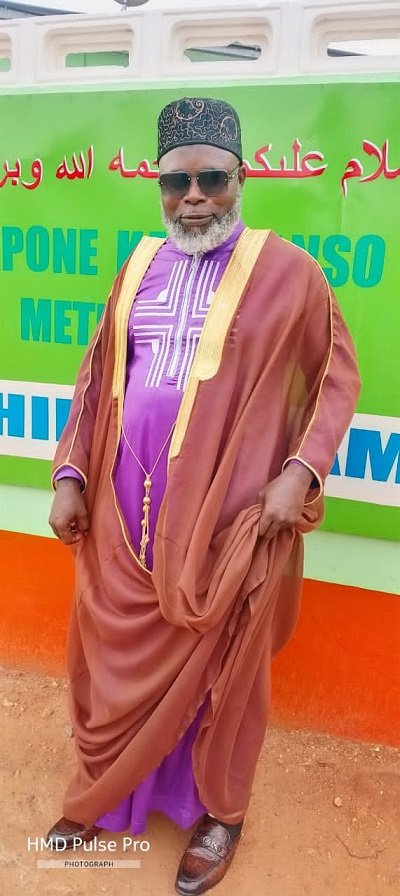Fruitful Living
Eid-ul-Adha: A living legacy of faith, sacrifice, and devotion

We begin in the name of Allah, the Most Merciful, the Most Compassionate. We praise Him, seek His help and forgiveness, and seek refuge in Him from the evils of our souls and the wrongs of our actions.
May peace and blessings be upon the Prophet Muhammad (peace be upon him), his family, his noble companions, and all those who follow his path until the Day of Judgment.
Understanding the essence
of Eid-ul-Adha
Eid-ul-Adha, the Festival of Sacrifice, is one of the two major Islamic celebrations observed by Muslims across the world.
It commemorates the unwavering submission of Prophet Ibrahim (Abraham, peace be upon him) to Allah’s command when he was prepared to sacrifice his beloved son Isma’il (Ishmael, peace be upon him). Allah, in His infinite mercy, intervened and replaced the son with a ram, thus honouring Ibrahim’s sincerity and faith.
This moment of sacrifice is recorded in the Qur’an: “Then when they had both submitted and he put him down upon his forehead, We called out: ‘O Ibrahim! You have fulfilled the vision.’ Indeed, We thus reward the doers of good.” (Surah As-Saffat, 37:103–105)
This act of obedience is not merely a historical account. It is a living symbol that forms the essence of Eid-ul-Adha.
Ibrahim (A.S): The Architect
of Submission
Before the moment of sacrifice, Prophet Ibrahim and his family played critical roles in establishing Islam’s foundational pillars:
1. The building of the Ka‘bah
Prophet Ibrahim and his son Isma’il were chosen to construct the Ka‘bah, the sacred House of Allah in Makkah. The Qur’an records this noble moment:
“And [mention] when Ibrahim was raising the foundations of the House and [with him] Isma’il, [saying], ‘Our Lord, accept [this] from us. Indeed, You are the Hearing, the Knowing.’”
(Surah Al-Baqarah 2:127)
This structure remains the spiritual centre of Muslim worship, facing which over a billion Muslims direct their daily prayers.
2. The struggle of Hajar (Hajara) between Safa and Marwa
The mother of Isma’il, Hajar (Hajara), exemplifies a profound lesson of patience and faith. Left in the barren valley of Makkah with her infant, she ran between the hills of Safa and Marwa, desperately searching for water. Her perseverance was rewarded when the well of Zamzam sprang forth at the feet of her baby.
Her sincere struggle is now ritualised in Hajj as the Sa‘i between Safa and Marwa—a reminder of the role of women, the power of du‘a, and the value of trust in Allah’s provision.
Sacrifice at Mina and the
Rites of Jamarat
During Hajj, pilgrims reenact Ibrahim’s confrontation with Shaytan at Mina, where he rejected the devil’s temptation and cast stones at him. This act is now observed in Hajj as the ritual of stoning the Jamarat, symbolising the rejection of evil, temptation, and disobedience.
It is a vivid spiritual lesson: the path to Allah is one of resistance to distraction and sin, and one must be prepared to fight these forces with unwavering faith.
The essence of Arafat in Hajj
The Prophet Muhammad said:“Hajj is Arafah.” (Sunan al-Tirmidhi, 889)
Standing on the plain of Arafat, in deep humility and supplication, is the heart of Hajj. It represents the Day of Judgment, when all of humanity will stand before their Creator. The Prophet said: “There is no day on which Allah frees more people from the Fire than the Day of Arafah.” (Sahih Muslim, 1348)
For pilgrims, Arafat is a time of repentance, reflection, and renewal— and for non-pilgrims, fasting on that day is highly recommended.
Three core lessons from the
Sacrifice of Prophet Ibrahim
(A.S.)
1. Absolute obedience to Allah
Ibrahim’s willingness to sacrifice his son teaches that the essence of faith is unquestioning obedience to Allah. He prioritised divine command over emotion, logic, or comfort.
Takeaway:
In our lives, we must also be ready to put aside our desires, egos, and even attachments if they conflict with Allah’s instructions. This may involve sacrifices such as waking up for Fajr, staying away from haram income, or being truthful in difficult situations.
2. Sincere intention and inner sacrifice
The real essence of the sacrifice lies in the heart’s submission to Allah.
It is neither their meat nor their blood that reaches Allah, but it is your piety that reaches Him.”
(Surah Al-Hajj 22:37)
Takeaway:
Every act of worship should be grounded in sincerity. Whether it is prayer, charity, or sacrifice, what matters most is the purity of our intention.
3. Sacrifice for the greater good
The legacy of Eid-ul-Adha teaches us that sometimes, faith requires us to give up what we love for a greater purpose. Sacrificing wealth, time, or status in the path of Allah or for the benefit of others leads to spiritual elevation.
Takeaway:
Use your resources such as time, money, skills, for acts of benefit: support the poor, educate the young, assist the sick, and build your community.
Celebrating Eid-ul-Adha: A
Festival for all Muslims
Even for those who do not go on Hajj, Eid-ul-Adha holds immense significance. Muslims across the world participate in the act of Qurbani (sacrifice) to honor the tradition of Ibrahim (A.S.).
Types of animals and their
symbolism
Permissible animals include goats, sheep, cows, and camels. Each must meet a minimum age and be free of defects. The sacrificed animal is then divided into three parts: one for the family, one for relatives and friends, and one for the poor and needy.
This distribution reflects the spirit of sharing, compassion, and social responsibility—values at the heart of Islam.
The eternal message of Eid-ul-Adha
Eid-ul-Adha is not merely a celebration; it is a living tradition that calls us to:
• Submit like Ibrahim,
• Strive like Hajar,
• Sacrifice like Isma’il,
• Reflect like the pilgrims at Arafat.
May this Eid awaken within us a renewed commitment to obedience, sincerity, and compassion.
Let us make every Eid-ul-Adha a step forward in our spiritual journey, embodying the values of submission, sacrifice, and service to humanity. I wish every Muslim Eid Mubaarak
By Imaam Alhaji Saeed Abdulai
(Kpone Katamanso Metropolitan Chief Imaam)
Fruitful Living
Sanitation, Hygiene, and the Morality of Public Space: Reclaiming Ghana’s Civic Virtue through Faith and Policy (Final Part)
A. The Role of Religious Leaders and Counsellors
Religious leaders wield immense influence in shaping public values. Every mosque, church, and shrine should integrate environmental stewardship into its doctrine. Islam views the earth as a masjid—a place of prostration (Sahih Bukhari, 335). Polluting it is akin to defiling a sacred space. Monthly khutbahs should focus on amanah and tahārah, connecting spiritual purity to environmental discipline.
As a counsellor, I affirm that behavioural reform requires both moral teaching and psychological reinforcement. When believers internalise that cleaning a drain is an act of ʿibādah (worship), they transform routine labour into sacred service. The Prophet (peace be upon him) taught: “Removing harmful things from the path is a branch of faith.” (Sahih Muslim, 35). This hadith perfectly captures the theology of civic virtue.
B. Individual and Community Pledge
Moral renewal begins with personal accountability. Every household must adopt responsible waste practices—segregating recyclables, composting, and cooperating with collection services. Citizens must also exercise al-amr bi-l-maʿrūf wan-nahy ʿani-l-munkar (enjoining good and forbidding evil) by correcting neighbours who litter or misuse public spaces, with gentleness and wisdom (Qur’an 16:125).
Communities should establish local sanitation committees under mosque and church leadership, creating faith-driven accountability structures. Supporting local enforcement, rather than resisting it, must be seen as a contribution to maslahah—the public interest that the Sharia seeks to protect.
This collective moral reawakening must integrate faith, governance, and citizenship into one moral project: cleanliness as worship, sanitation as patriotism.
C. Conclusion: Cleanliness, Dignity, and the Maqāṣid al-Sharīʿah
Ghana’s destiny as a great nation is inseparable from the cleanliness of its environment and the conscience of its citizens. The choked gutters, polluted rivers, and scattered waste are not only environmental failures but spiritual wounds upon our collective soul. The Prophet (peace be upon him) said: “Allah is pure and accepts only what is pure.” (Sahih Muslim, 1015). A nation that aspires to divine favour must first reflect divine purity in its public spaces.
To achieve this, we must view sanitation through the lens of the Maqāṣid al-Sharīʿah—the higher objectives of Islamic law—which aim to preserve life (ḥifẓ al-nafs), faith (ḥifẓ al-dīn), intellect (ḥifẓ al-ʿaql), wealth (ḥifẓ al-māl), and posterity (ḥifẓ al-nasl). Clean environments are essential for all five objectives:
- Preservation of Life (ḥifẓ al-nafs): Proper sanitation prevents disease and death. Protecting human health is a divine imperative. Allah says, “And do not throw yourselves with your own hands into destruction.” (Qur’an 2:195).
- Preservation of Faith (ḥifẓ al-dīn): Islam equates purity with faith. An unclean environment obstructs worship and spiritual growth, violating the believer’s covenant of cleanliness.
- Preservation of Intellect (ḥifẓ al-ʿaql): Healthy surroundings promote clarity of thought, while pollution and disease diminish cognitive vitality and learning.
- Preservation of Wealth (ḥifẓ al-māl): Waste management safeguards public funds, prevents costly health crises, and preserves natural resources.
- Preservation of Posterity (ḥifẓ al-nasl): Environmental care ensures a habitable planet for future generations, fulfilling our amanah to the unborn.
By aligning sanitation with these higher objectives, we transform a civic duty into a sacred mission. Achieving the Maqāṣid requires cooperation between policy and piety—laws enforced justly, education grounded in values, and citizens inspired by faith.
Let every believer remember that a clean street is a silent dhikr (remembrance of Allah), a purified drain is a fulfilled amanah, and a healthy neighbour is a protected trust. When our gutters run clear and our air smells fresh, it will signify not merely progress but piety—proof that Ghana has reclaimed its moral and civic virtue under the gaze of the Almighty Allah.
Thank you.
- By Imam Alhaji SaeedBAbdulai, the Author
Join our WhatsApp Channel now!
https://whatsapp.com/channel/0029VbBElzjInlqHhl1aTU27
Fruitful Living
Being a Channel of Truth and Hope (Part III – Final)
B. Instead, walk in righteousness and true holiness … (20–24)
1. This is how you learned Christ
- As you heard Him and were taught by Him (through His apostles, of course – Matt. 28:19-20)
- In Whom is the truth – John 8:31; 14:6
2. For you were taught to “put off” the “old man”
- That is, your “former conduct,” how you behaved before you were saved – Col. 3:5-9
- Putting off the old man is needed because it is never content, but grows corrupt according to the deceitful lusts (like addictive drugs, you always need more).
3. And to “be renewed in the spirit of your mind”
- Which is the key to true “transformation” – Rom. 12:1-2
- You “renew your mind” only as you “set your mind on things above” – Col. 3:1-2
4. And to “put on the new man”
- A new man “which was created according to God” – Col. 3:10
- A new man, “in righteousness and true holiness” – Col. 3:12-17
In giving the admonition “No longer walk as the rest of the Gentiles,” Paul has made it clear that it involves both a “putting off” and a “putting on.” That is, our “Walking in Truth and Holiness” is not just a bunch of “Thou Shalt Not’s,” there are also some “Thou Shalt’s.”
To illustrate further the difference between the “old man” (how the rest of the Gentiles walk) and the “new man” (how Christians are to walk), we find Paul making…
II. The Application – (25–32)
Case in point: lying (25)
- The “old man” thinks nothing of lying
- The “new man” puts away lying, and in its place speaks truth with his neighbor (especially to those who are members of the same body)
Case in point: anger (26–27)
- The “old man” gets angry and lets it linger, or get out of control
- The “new man” may get angry, but does not…
- Let it linger (“do not let the sun go down on your wrath”)
- Allow it to prompt sinful behavior (“nor give place to the devil”)
Case in point: stealing (28)
- The “old man” is willing to steal
- The “new man” not only stops stealing, but works so he can help others in need!
Case in point: corrupt communication (29)
- The “old man” doesn’t worry or care what comes out of his mouth
- The “new man” not only avoids “corrupt communication,” but seeks to speak that which is uplifting to those who hear
Summary (30–32)
Why be concerned about putting off the “old man” and putting on the “new man?”
When Christians act like the “old man,” it grieves the Holy Spirit. By the Holy Spirit we were sealed for the day of redemption – Eph. 1:13-14.
Therefore, we ought to put away those things befitting the “old man” (bitterness, wrath, anger, clamor, evil speaking, malice). And in its place, we need to put on those things befitting the “new man” (being kind, tenderhearted, forgiving one another just as God forgives us in Christ).
Conclusion
What a contrast there would be if all those in the church truly carried out the admonition to “Walk in Truth and Holiness!” The church would stand out like “a city that is set on a hill” – Matt. 5:14-16.
And the world, though it now has “their understanding darkened,” would be more likely to come to see the truth that is in Jesus. But what hope is there if the church is more like the world than the “holy temple” it is to be?
Brethren, are we “grieving the Holy Spirit of God?” – Ephesians 4:30. While the increasing worldliness in our society naturally concerns us, let us be careful not to react with attitudes that reveal our old characteristic when we were in the world.
BY Rev. Dr Joyce Aryee,
the author







